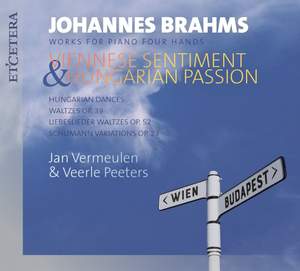Brahms had been an unreserved admirer of the hundreds of waltzes and Landler that Schubert had composed even before he himself arrived in Vienna. He was just as lyrically enthusiastic about the waltzes of his contemporary Johann Strauss II. It is clear that Brahms, like Schubert and Chopin, took lighter genres such as the waltz very seriously. This can be seen in the wealth of melody, the variation of rhythm and the lush harmonies of the Waltzes op. 39. These were composed in 1865, three years after he had settled in Vienna. It is astonishing to see how a Northern German could feel so at home in every genre that he attempted; he is completely at ease with the gypsy idiom and seems also to be Viennese-born and bred. Brahms raises the folk character of Georg Friedrich Daumers poems to an ultimate refinement in his Liebesliederwalzer op. 52. The work was initially intended for vocal quartet (the vocal parts are marked ad libitum in the original edition) and piano four hands; the marking ad libitum is apposite, given that the work is just as effective without the vocal parts. It is, however, well worth taking a look at Daumers poems just to see and hear how ingeniously Brahms handled them. Given that such an album as this requires variety and contrast, we have not only alternated Hungarian dances with waltzes but also have placed Brahms profound Variationen uber ein Thema von Robert Schumann op. 23 at the centre of these otherwise light-footed works. Jan Vermeulens series of twelve CDs of the complete works of Schubert for piano solo was greeted with praise by the Belgian and the international music press. Veerle Peeters made her name as the founder of the Frescamente ensemble, which swiftly won prizes in the Almere International Chamber Music Competition in the Netherlands and in the Belgian Gouden Vleugels. She confirmed her reputation with an internationally praised CD of the piano works of the early 20th century French woman composer Mel Bonis.



